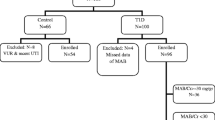Abstract
In a previous study, we found urinary excretion of Tamm-Horsfall protein (THP) to be persistently decreased in 25% of patients during the first year after diagnosis of diabetes mellitus. We thus wanted to study another marker for distal tubular function, pi glutathione S-transferase (π-GST) and compare this and THP with proximal tubular function evaluated with α-GST and α-1-microglobulin (HC) in patients with longer duration of diabetes. One hundred and eighty-four diabetic and 16 control children were studied with timed overnight urine collections. Median age was 14 years, and median age at diagnosis was 8 years. The urinary excretion of α- and π-GST was significant lower in diabetic than control children. There were no differences in the excretion of HC and THP. Diabetic children with decreased α-GST had higher albumin excretion, HbA1c levels, and longer diabetes duration but decreased THP excretion and cystatin-C clearance compared with those with normal excretion. In contrast, a decreased π-GST or THP excretion was not associated with such differences. Diabetic children with increased HC excretion had increased HbA1c levels. Diabetic children, before the stage of microalbuminuria, may have signs of both proximal and distal tubular dysfunction, which is related to diabetes duration and poor metabolic control. Alpha-GST and π-GST seem to be more sensitive than other parameters studied.
Similar content being viewed by others
References
Holmquist P, Torffvit O, Jørgensen PE, Tørring N, Nexø E, Sjöblad S (2001) Early urinary changes in Tamm-Horsfall protein and epidermal growth factor in diabetic children. Pediatr Nephrol 16:488–492
Sejdiu I, Torffvit O (2007) Decreased urinary concentration of Tamm-Horsfall protein is associated with development of renal failure and cardiovascular death within 20 years in type 1 but not in type 2 diabetic patients. Scan J Urol Nephrol 28:1–7
Korpinen E, Teppo A-M, Hukkanen L, Åkerblom HK, Grönhagen-Riska C, Vaarala O (2000) Urinary transforming growth factor-β1 and α1-microglobulin in children and adolescents with type1 diabetes. Diabetes Care 23:664–668
Sundberg A, Appelkvist E-L, Dallner G, Nilsson R (1994) Glutathione transferases in the urine: Sensitive methods for detection of kidney damage induced by nephrotoxic agents in humans. Environ Health Perspect 102(Suppl 3):293–296
Harrison DJ, Kharbanda R, Scott Cunningham D, Mc Lellan, Hayes JD (1989) Distribution of glutathione S-transferase isoenzymes in human kidney: basis for possible markers of renal injury. J Clin Pathol 42:624–628
Branten AJ, Mulder TP, Peters WH, Assmann KJ, Wetzels JF (2000) Urinary excretion of glutathione S transferases alpha and pi in patients with proteinuria: reflection of the site of tubular injury. Nephron 85:120–126
Thulesen J, Jørgensen PE, Torffvit O, Nexø E, Poulsen SS (1997) Urinary excretion of epidermal growth factor and Tamm-Horsfall protein in three rat models with increased renal excretion of urine. Regulatory Pept 72:179–186
Torffvit O, Melander O, Hulten L (2004) Urinary excretion rate of Tamm-Horsfall protein is related to salt intake in humans. Nephron Physiol 97:31–36
Bin Z, Hanchao S, Junfu Z, Feili L, Ying H (2005) Effects of simvastin on oxidative stress in streptozotocin-induced diabetic rats: A role for glomeruli protection. Nephron Exp Nephrol 101:e1–e8
Suchocka Z, Kobylinska K, Pachecka J (1995) Activity of glutathione-dependent enzymes in long term diabetes II. Glutathione contents and activity of glutathione-dependent enzymes: S-transferase and peroxides in the kidney cytosol of alloxan induced diabetic rats. Acta Pol Pharm 52:213–217
Fujita H, Haseyama T, Kayo T, Nozaki J, Wada Y, Ito S, Koizumi A (2001) Increased expression of Glutathione S-Transferase in renal proximal tubules in the early stages of diabetes: A study of type-2 diabetes in the akita mouse model. Exp Nephrol 9:380–386
Torffvit O, Agardh CD, Kjellsson B, Wieslander J (1992) Tubular secretion of Tamm-Horsfall protein in type1 (insulin-dependent) diabetes mellitus using a simplified enzyme linked immunoassay. Clin Chim Acta 205:31–41
Torffvit O, Wieslander J (1986) A simplified enzyme-linked immunosorbent assay for urinary albumin. Scand J Clin Lab Invest 46:545–548
Kyhse-Andersen J, Schmidt C, Nordin G, Andersson B, Nilsson-Ehle P, Lindström V, Grubb A (1994) Serum cystatin-C, determined by a rapid, automated particle-enhanced turbidimetric method, is a better marker than serum creatinine for glomerular filtration rate. Clin Chem 40:1921–1926
Tencer J, Thysell H, Grubb A (1996) Analysis of proteinuria: reference limits for urine excretion of albumin, protein HC, immunoglobulin G, K- and λ-immunoreactivity, orosomucoid and α-antitrypsin. Scand J Clin Lab Invest 56:691–700
Grubb A, Nyman U, Björk J, Lindström V, Rippe B, Sterner G, Christensson A (2005) Simple Cystatin- C based prediction equations for glomerular filtration rate compared with the modification of diet in renal disease prediction equation for adults and the Schwartz and Counahan-Barratt prediction equations for children. Clin Chem 51:1420–1431
Agardh CD, Stenram U, Torffvit O, Agardh E (2002) Effects of inhibition of glycation and oxidative stress on the development of diabetic nephropathy in rats. J Diabet Complications 16:395–400
Yang Y, Kao MT, Chang CC, Chung SY, Chen CM, Tsai JJ, Chang JG (2004) Glutathione S-transferase T1 deletion is a risk factor for developing end-stage renal disease in diabetic patients. Int J Mol Med 14:855–859
Rudberg S, Østerby R, Bangstad H-J, Dahlquist G, Persson B (1999) Effect of angiotensin converting enzyme inhibitor or beta blocker on glomerular structural changes in young microalbuminuric patients with type1 (insulin-dependent) diabetes mellitus. Diabetologia 42:589–595
Østerby R, Bangstad H-J, Rudberg S (2000) Follow-up study of glomerular dimensions and cortical interstitium in microalbuminuric type1 diabetic patients with or without antihypertensive treatment. Nephrol Dial Transplant 15:1609–1616
Gulmann C, Østerby R, Bangstad H-J, Rudberg S (2001) The juxtaglomerular apparatus in young type-1 diabetic patients with microalbuminuria. Effect of antihypertensive treatment. Virchows Arch 438:618–623
Acknowledgment
The help from Åsa Pettersson, Renal Research Laboratory, and the staff of the Paediatric Department in Lund, is highly appreciated. The study was supported by Biotrin, who provided the assays for GST and the preservative.
Author information
Authors and Affiliations
Corresponding author
Rights and permissions
About this article
Cite this article
Holmquist, P., Torffvit, O. Tubular function in diabetic children assessed by Tamm-Horsfall protein and glutathione S-transferase. Pediatr Nephrol 23, 1079–1083 (2008). https://doi.org/10.1007/s00467-008-0770-9
Received:
Revised:
Accepted:
Published:
Issue Date:
DOI: https://doi.org/10.1007/s00467-008-0770-9




